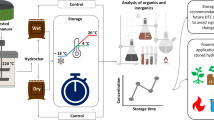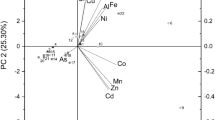Abstract
Recently, we reported that the carbon isotope composition of the solid residues obtained by freeze-drying white and red wines (δ13CWSR) could be used for tracing the water status of the vines whose grapes were used to produce them. Here, we compare different methods using δ13C values of other wine components, particularly those of whole wine (δ13CWW) obtained by elemental analysis and isotope ratio mass spectrometry (EA/IRMS) and of wine ethanol (δ13CWEtOH) obtained by gas chromatography/combustion/IRMS (GC/C/IRMS), for their suitability to assess the vine water status. The studied wines were obtained from field-grown cultivars (Vitis vinifera L. cv. Chasselas, Petite Arvine, and Pinot noir) under different water treatments during the 2009–2014 seasons and were the same wines in which the δ13CWSR was measured previously. The EA/IRMS method for whole wine used two successive EA analytical cycles in each acquisition period to reduce the residence time of the sample capsules in the autosampler. The sample aliquots for the EA/IRMS and GC/C/IRMS analyses were optimized for peak-size differences less than 10% between the sample and reference gas. For all wine varieties, the δ13CWW and δ13CWEtOH values were linearly correlated with the predawn leaf water potential (Ψpd) and therefore serve as reliable indicators of vine water status, as do the δ13C values for must sugars and wine solid residues. The strongest negative correlations with Ψpd were for δ13Csugars (r = −0.94, n = 54) and δ13CWEtOH (r = −0.91) and were lower but still highly significant (p < 0.00001) for δ13CWW (r = −0.71) and δ13CWSR (r = −0.70). An evaluation of the advantages and drawbacks of the different methods is presented, showing that the δ13C analysis of wine ethanol by GC/C/IRMS is the most appropriate.





Similar content being viewed by others
References
Rossmann A, Schmidt HL, Reniero F, Versini G, Moussa I, Merle MH. Stable carbon isotope content in ethanol of EC data bank wines from Italy, France and Germany. Z Lebensm Unters Forsch. 1996;203:293–301.
Spangenberg JE, Macko SA, Hunziker J. Characterization of olive oil by carbon isotope analysis of individual fatty acids: implications for authentication. J Agric Food Chem. 1998;46:4179–84.
Ogrinc N, Kosir IJ, Spangenberg JE, Kidrić J. The application of NMR and MS methods for detection of adulteration of wine, fruit juices, and olive oil. A review. Anal Bioanal Chem. 2003;376:424–30.
Richter EK, Spangenberg JE, Kreuzer M, Leiber F. Characterization of rapeseed (Brassica napus) oils by bulk C, O, H, and fatty acid C stable isotope analyses. J Agric Food Chem. 2010;58:8048–55.
Spangenberg JE. Bulk C, H, O, and fatty acid C stable isotope analyses for purity assessment of vegetable oils from the southern and northern hemispheres. Rapid Commun Mass Spectrom. 2016;30:2247–461.
O’Neill BC, Oppenheimer M, Warren R, Hallegatte S, Kopp RE, Portner HO, et al. IPCC reasons for concern regarding climate change risks. Nat Clim Chang. 2017;7:28–37.
van Leeuwen C, Tregoat O, Chone X, Bois B, Pernet D, Gaudillère JP. Vine water status is a key factor in grape ripening and vintage quality for red Bordeaux wine. How can it be assessed for vineyard management purposes? I Int Sci Vigne Vin. 2009;43:121–34.
Pagay V, Zufferey V, Lakso AN. The influence of water stress on grapevine (Vitis vinifera L.) shoots in a cool, humid climate: growth, gas exchange and hydraulics. Funct Plant Biol. 2016;43:827–37.
Medrano H, Escalona JM, Bota J, Gulias J, Flexas J. Regulation of photosynthesis of C-3 plants in response to progressive drought: stomatal conductance as a reference parameter. Ann Bot. 2002;89:895–905.
Farquhar GD, Ehleringer JR, Hubick KT. Carbon isotope discrimination and photosynthesis. Annu Rev Plant Physiol Plant Mol Biol. 1989;40:503–37.
Gaudillère JP, van Leeuwen C, Ollat N. Carbon isotope composition of sugars in grapevine, an integrated indicator of vineyard water status. J Exp Bot. 2002;53:757–63.
Chone X, van Leeuwen C, Dubourdieu D, Gaudillere JP. Stem water potential is a sensitive indicator of grapevine water status. Ann Bot. 2001;87:477–83.
de Souza CR, Maroco JP, dos Santos TP, Rodrigues ML, Lopes CM, Pereira JS, et al. Impact of deficit irrigation on water use efficiency and carbon isotope composition (delta C-13) of field-grown grapevines under Mediterranean climate. J Exp Bot. 2005;56:2163–72.
van Leeuwen C, Tregoat O, Pernet D, Roby JP, Cellie N, Gaudillère JP. Use of sarbon isotope discrimination on grape sugar as a tool for practical vineyard management. Am J Enol Vitic. 2009;60:394A.
Jackson RS. Wine science. Principles and applications. New York: Elsevier/Academic Press; 2014.
Breda N, Granier A, Barataud F, Moyne C. Soil water dynamics in an oak stand. I. Soil moisture, water potentials and water uptake by roots. Plant Soil. 1995;172:17–27.
Pellegrino A, Lebon E, Simonneau T, Wery J. Towards a simple indicator of water stress in grapevine (Vitis vinifera L.) based on the differential sensitivities of vegetative growth components. Aust J Grape Wine Res. 2005;11:306–15.
Guyon F, van Leeuwen C, Gaillard L, Grand M, Akoka S, Remaud GS, et al. Comparative study of 13C composition in ethanol and bulk dry wine using isotope ratio monitoring by mass spectrometry and by nuclear magnetic resonance as an indicator of vine water status. Anal Bioanal Chem. 2015;407:9053–60.
Spangenberg JE, Vogiatzaki M, Zufferey V. Gas chromatography and isotope ratio mass spectrometry of Pinot noir wine volatile compounds (δ 13C) and solid residues (δ 13C, δ 15N) for the reassessment of vineyard water-status. J Chromatogr A. 2017;1517:142–55.
Zufferey V, Spring JL, Verdenal T, Dienes A, Belcher S, Lorenzini F, et al. Influence of water stress on plant hydraulics, gas exchange, berry composition and quality of Pinot noir wines in Switzerland. OENO One. 2017;51:37–57.
Spangenberg JE, Zufferey V. Changes in soil water availability in vineyards can be traced by the carbon and nitrogen isotope composition of dried wines. Sci Total Environ. 2018;635:178–87.
Cabañero AI, Recio JL, Ruperez M. Isotope ratio mass spectrometry coupled to liquid and gas chromatography for wine ethanol characterization. Rapid Commun Mass Spectrom. 2008;22:3111–8.
Spitzke ME, Fauhl-Hassek C. Determination of the 13C/12C ratios of ethanol and higher alcohols in wine by GC-C-IRMS analysis. Eur Food Res Technol. 2010;231:247–57.
Coplen TB. Guidelines and recommended terms for expression of stable-isotope-ratio and gas-ratio measurement results. Rapid Commun Mass Spectrom. 2011;25:2538–60.
Brand WA. New reporting guidelines for stable isotopes – an announcement to isotope users. Isot Environ Health Stud. 2011;47:535–6.
Schimmelmann A, Qi HP, Coplen TB, Brand WA, Fong J, Meier-Augenstein W, et al. Organic reference materials for hydrogen, carbon, and nitrogen stable isotope-ratio measurements: caffeines, n-alkanes, fatty acid methyl esters, glycines, L-valines, polyethylenes, and oils. Anal Chem. 2016;88:4294–302.
Bruno TJ, Lide DR, Rumble JR, editors. CRC handbook of chemistry and physics, 99th edn (Internet Version). Boca Raton: CRC Press; 2018.
Bisson LF, Joseph CML. Yeasts. In: König H, Unden G, Fröhlich J, editors. Biology of microorganisms on grapes, in must and in wine. Berlin-Heidelberg: Springer; 2009. p. 47–60.
Rossmann A, Butzenlechner M, Schmidt HL. Evidence for a non-statistical carbon isotope distribution in natural glucose. Plant Physiol. 1991;96:609–14.
Hobbie EA, Werner RA. Intramolecular, compound-specific, and bulk carbon isotope patterns in C3 and C4 plants: a review and synthesis. New Phytol. 2004;161:371–85.
Pretorius IS. Tailoring wine yeast for the new millennium: novel approaches to the ancient art of winemaking. Yeast. 2000;16:675–729.
Bayle K, Akoka S, Remaud GS, Robins RJ. Nonstatistical 13C distribution during carbon transfer from glucose to ethanol during fermentation is determined by the catabolic pathway exploited. J Biol Chem. 2015;290:4118–28.
Gilbert A, Silvestre V, Segebarth N, Tcherkez G, Guillou C, Robins RJ, et al. The intramolecular 13C-distribution in ethanol reveals the influence of the CO2-fixation pathway and environmental conditions on the site-specific 13C variation in glucose. Plant Cell Environ. 2011;34:1104–12.
Waterhouse AL. Elias RJ (2010) chemical and physical deterioration of wine. In: Skibsted LH, Risbo J, Andersen ML, editors. Chemical deterioration and physical instability of food and beverages. Cambridge: Woodhead; 2010. p. 466–82.
Acknowledgments
The stable isotope facilities were funded by the University of Lausanne. The authors are very grateful to Fabrice Forenzini and Johannes Rösti for providing bottles of Leytron wines and a standard aqueous solution of wine-derived ethanol.
Author information
Authors and Affiliations
Corresponding author
Ethics declarations
Conflict of interest
The authors declare that they have no conflicts of interest.
Ethical approval
This article does not contain any studies with human participants or animals performed by any of the authors.
Additional information
Publisher’s note
Springer Nature remains neutral with regard to jurisdictional claims in published maps and institutional affiliations.
Electronic supplementary material
ESM 1
(PDF 139 kb)
Rights and permissions
About this article
Cite this article
Spangenberg, J.E., Zufferey, V. Carbon isotope compositions of whole wine, wine solid residue, and wine ethanol, determined by EA/IRMS and GC/C/IRMS, can record the vine water status—a comparative reappraisal. Anal Bioanal Chem 411, 2031–2043 (2019). https://doi.org/10.1007/s00216-019-01625-4
Received:
Revised:
Accepted:
Published:
Issue Date:
DOI: https://doi.org/10.1007/s00216-019-01625-4




